The Gaines-McGowan site is located in Sabine County in what is now the Toledo Bend Reservoir. Once above water, the Gaines-McGowan site featured the eponymous house which served as a residence that was continually occupied from its construction in 1819 to its deconstruction in 1966 in preparation for the site’s inundation. James Gaines, an important figure in both the local area’s and state’s history, constructed the house in 1819, and it served as not only a residence for himself, his wife, and their five children, but also as a part of the Gaines Ferry complex (which he ran) due to its proximity to the river; this ferry was an important component of the economy in early-19th century Sabine County, which flourished under the auspices of the trade and immigration that came into this region through the rivers. Additionally, with Gaines’ business pursuits including the ferry business as well as running a post office, mercantile establishment, and a tavern, the house also functioned as a community hub. The timeline on the right side of the page shows the occupants of the site.
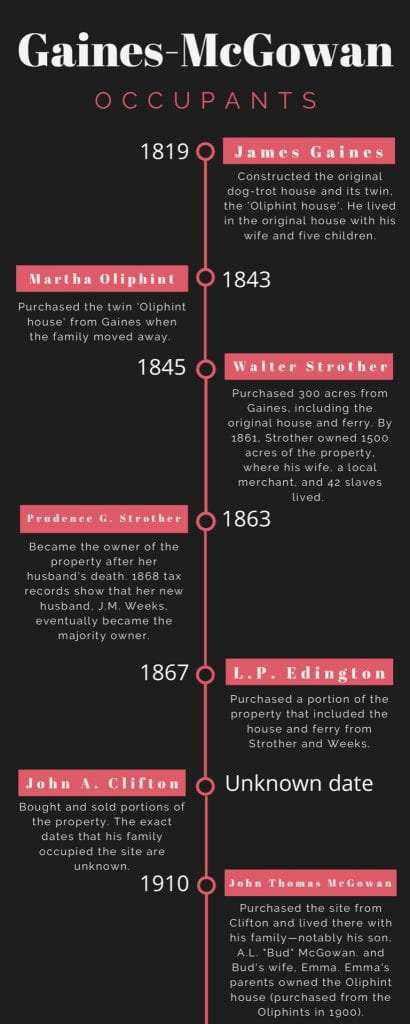
The excavation of the Gaines-McGowan house ran from January 10th to 30th, 1968. The goal of the project was to salvage information related to the site’s architecture and artifacts before it was inundated by the Toledo Bend Reservoir. The excavation was funded and performed by the Archaeology Research Program at SMU through a National Parks Service contract and the State Building Commission Archaeology Division (which is now known as the Office of the State Archaeologist, Division of the Texas Historical Commission); Harald Jensen served as the Principal Investigator.
With museum exhibits often focusing on famous historical events and figures, the goal of this exhibit is to provide viewers an intimate look into the daily lives and households of Texans living in this region in 19th and 20th centuries. The changes in material culture captured through the artifacts at the Gaines-McGowan site and in this exhibit show how greater historical events and patterns ripple into the daily lives of the people who live through them.
Featured Artifacts
Ceramic Artifacts
Royal China Company plate
Material: Refined Earthenware
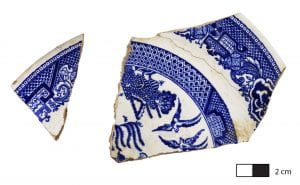
This is a small earthenware, transfer print dinner plate. The plate itself is white, and the transfer printed design is monochromatic cobalt blue; the entire plate is coated in a transparent, colorless, and glossy glaze. There are very fine cracks—what is known as “crazing”—on the glaze coating of the plate.
Early transfer wares were first produced in the 1750s using a technique wherein potters would print designs onto ceramics using mediums created from engraved copper plates; these designs tended to be black in color. However, by the 1780s, manufacturers began creating underglaze blue transfer-printed wares using special transfer papers instead. The style became overwhelmingly popular.
Albany Slip-glaze Jug
Material: Stoneware
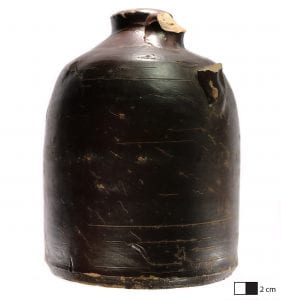
This is a stoneware Albany-type slip-glaze jug, which would have been used to store liquids and sealed with a cork. These locally-produced stonewares thus made up a large portion of the utilitarian wares in households in the region until the mid-1920s when the production of these wares declined in Texas and households began to acquire their utilitarian wares produced in the northern and midwestern parts of the United States.
Albany Salt-glaze Churn
Material: Stoneware
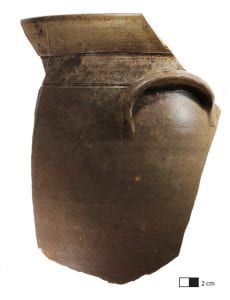
Utilitarian wares like this butter churn were produced by and procured from local Texas potteries. Salt glaze was the earliest type of glaze used for stonewares in the United States. During the production of these wares, potters would throw salt into the kiln at high heat, causing it to combine with the silicates on the surface of the vessels being fired and creating the salt glaze.
Coffee Cup
Material: Ironstone
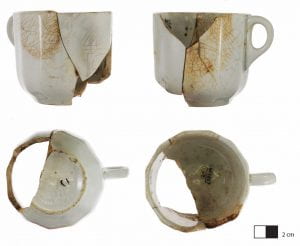
During the economically-difficult Civil War and Reconstruction eras, ceramics were more plain in design. Ironstone wares, such as this coffee mug, were produced by adding materials to the paste of a ceramic piece that lowered the firing temperature required to create a piece with glass-like hardness. The resulting ceramic is harder and more durable than other types of earthenware dishes are. Their usage coincides with the transition away from British-imported wares to American-made wares in the region.
Glazed Jars
Material: Stoneware
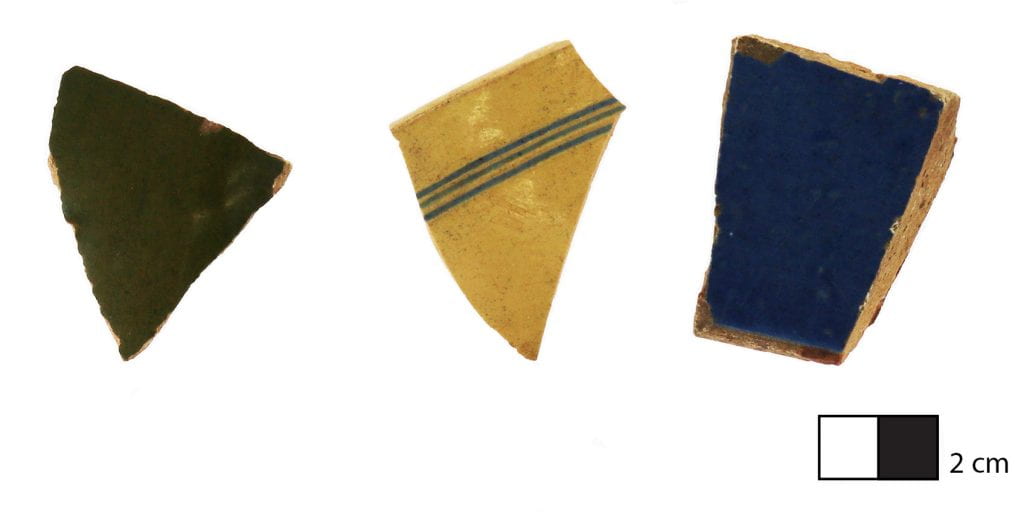
Produced in the midwestern United States during the early to mid-20th century where the American pottery industry flourished, these jars were used to store mustards and preserves. Bristol glazes were developed in Bristol, England and applied to utilitarian stoneware mustards and preserves. Bristol glazes were developed in Bristol, England and applied to utilitarian stonewares to cover the dull, “buff” colored clay pieces.
Tea Cup
Material: Porcelain
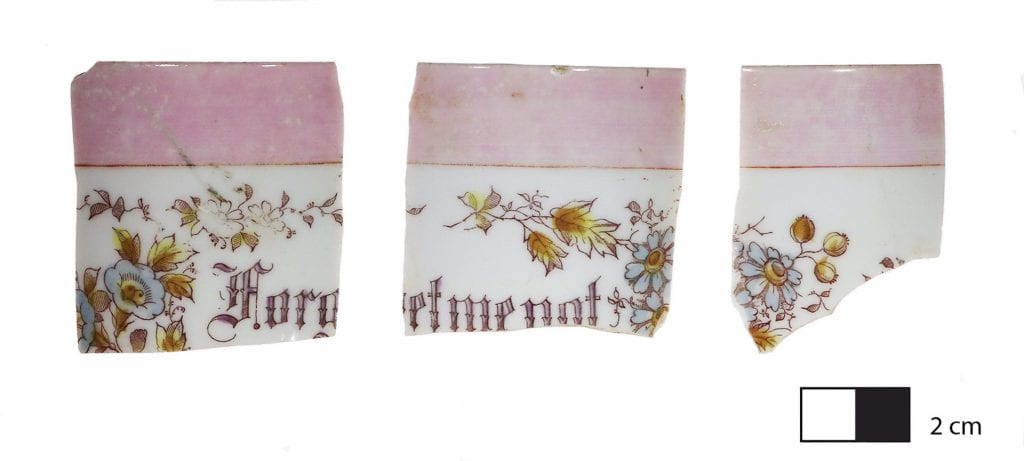
Cabinet teacups were never used for drinking, but instead served as decorative souvenir pieces. Porcelain wares are created through firing an extremely refined white paste that becomes glass-like and is finished with a hard, transparent glaze.
Edgeware Platter
Material: Refined Earthenware
This British-manufactured serving ware is decorated with a feather impressed, scalloped rim. Such designs were created by impressing curving lines onto the rim of the piece, painting the rim with a color (usually blue), and then applying a transparent colorless glaze over the ware.
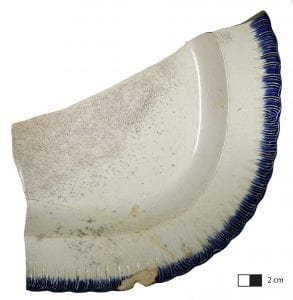
Polychrome Plate
Material: Refined Earthenware
Japanese ceramics like this plate became popular in the 20th century as imported goods became cheaper. While the exact date of manufacture of this plate is unknown, we know that it must have been produced after 1921 since the mark on the plate refers to Japan as ‘Japan’ and not ‘Nippon’, as it had been prior to this date.
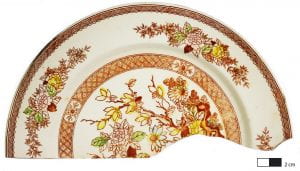
Doorknob and Shank
Material: Ceramic and Iron
This ceramic doorknob (with iron shank attached) was one of a dozen purchased in bulk from the Sears Roebuck & Co., possibly for renovation in 1897.
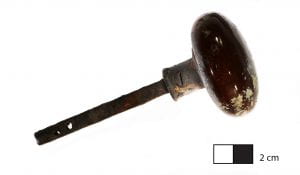
Further Reading:
James Taylor Gaines, Texas State Historical Association
Gains Ferry, Texas State Historical Association
References
Greer, Georgeanna H.
2000 Ceramic Artifacts Analysis. In The Gaines-McGown Site: Archaeological Investigations and Related Research. Manuscript on file, Department of Anthropology, Southern Methodist University, Dallas, TX
Office of the State Archaeologist Staff
2000 The Gaines-McGown Site: Archaeological Investigations and Related Research. Manuscript on file, Department of Anthropology, Southern Methodist University, Dallas, TX
O’Hara, Patricia
1993 “The Willow Pattern That We Knew”: The Victorian Literature of Blue Willow. Victorian Studies 36(4)”421-442.
Sebring Ohio Historical Society
n.d. Royal China Company. Web page, http://www.sebringohiohistoricalsociety.org/RoyalChina.html, accessed April 1, 2020
About the Author
 Jordan graduated in May 2020 from Southern Methodist University with a Bachelor of Science in anthropology and minors in statistical science and Chinese. In addition to being a Dedman College Scholar, she is a member of the University Honors Program, Phi Beta Kappa, and Lambda Alpha National Collegiate Honors Society for Anthropology, and was named the recipient of the 2020 Outstanding Senior in Anthropology Award. During her time at SMU, Jordan worked as an undergraduate research assistant in SMU’s Archaeology Research Collections and was named a 2018 Summer Research Fellow for her work with Native American human remains documentation and consultation. After graduation, she is interested in pursuing an English teaching assistantship in Taiwan and eventually graduate studies in the anthropology of East Asia with a focus on Taiwan.
Jordan graduated in May 2020 from Southern Methodist University with a Bachelor of Science in anthropology and minors in statistical science and Chinese. In addition to being a Dedman College Scholar, she is a member of the University Honors Program, Phi Beta Kappa, and Lambda Alpha National Collegiate Honors Society for Anthropology, and was named the recipient of the 2020 Outstanding Senior in Anthropology Award. During her time at SMU, Jordan worked as an undergraduate research assistant in SMU’s Archaeology Research Collections and was named a 2018 Summer Research Fellow for her work with Native American human remains documentation and consultation. After graduation, she is interested in pursuing an English teaching assistantship in Taiwan and eventually graduate studies in the anthropology of East Asia with a focus on Taiwan.